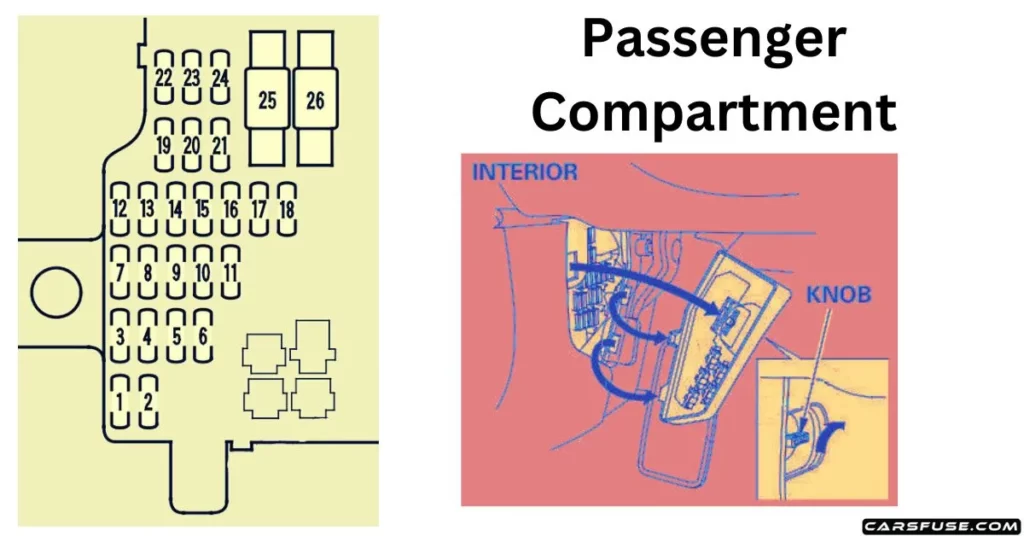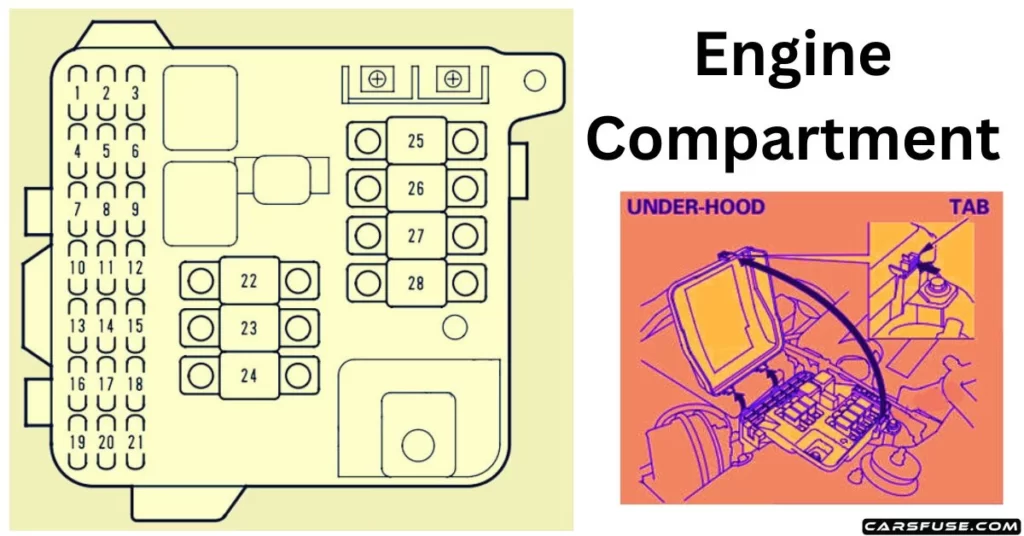The Acura RL KA9 is a luxury sedan that was produced from 1996 to 2004. It has two fuse boxes, one located under the hood and one located in the passenger cabin. This blog post will provide you with fuse box diagrams for both locations, as well as information on the amperage rating of each fuse.
The under-hood fuse box is located in the engine compartment next to the battery. It is covered by a black plastic cover with two tabs. To remove the cover, simply push in the tabs and lift.
The passenger cabin fuse box is located in the lower center console, behind the armrest. To access it, open the armrest and remove the fuse panel cover.
Table of Contents
Passenger Compartment Fuse Panel
The component is situated beneath the dashboard on the driver’s side. The space beneath the dashboard is often utilized to house a variety of crucial automotive components, ranging from electrical modules to controls for various vehicle systems.
Placing the component under the dashboard on the driver’s side ensures that it’s easily reachable by the driver. Additionally, positioning the component on the driver’s side aligns with the principle of driver-centric design. Essential controls and components are often situated on the side that’s more accessible and visible to the driver. This approach enhances safety and user experience, allowing the driver to focus on the road while making necessary adjustments.

Fuses in the Passenger compartment (2000-2003)
| Fuse Number | Fuse Amp. Rating | Protected Components |
|---|---|---|
| 1 | 15 A | Small Light |
| 2 | — | Not Used (OP) |
| 3 | 7.5 A | Rear Window Defogger Relay, Cooling Fan Relay |
| 4 | 10 A | Radio, ACC |
| 5 | 20 A | A/C Clutch, Heated Seat |
| 6 | 20 A | ECU (PCM) |
| 7 | 10 A | SRS |
| 8 | 20 A | Driver’s Power Seat |
| 9 | 20 A | Bose Audio System |
| 10 | 10 A | Daytime Running Lights (On Canadian models) |
| 11 | 20 A | Driver’s Power Seat |
| 12 | 7.5 A | Daytime Running Lights (On Canadian models) |
| 13 | 7.5 A | Meter, Moonroof |
| 14 | 7.5 A | Starter Signal |
| 15 | 7.5 A | ACG |
| 16 | 10 A | ACC Socket |
| 17 | 7.5 A | Power Window MPCS |
| 18 | 20 A | Front Right Power Window |
| 19 | 7.5 A | Mirror |
| 20 | 20 A | ECU (Body) |
| 21 | 20 A | Rear Right Power Window |
| 22 | 20 A | Fuel Pump |
| 23 | 7.5 A | SRS |
| 24 | 20 A | Rear Left Power Window |
| 25 | 30 A | Ignition Coils |
| 26 | — | Not Used |
Note: Cigar lighter / power outlet fuse in the Acura RL is the fuse No.16 in the Passenger compartment.
Fuses in the Passenger Compartment (2004)
| Fuse Number | Fuse Amp. Rating | Protected Components |
|---|---|---|
| 1 | 15 A | Small Light |
| 2 | — | Not Used (OP) |
| 3 | 7.5 A | Condenser Fan Relay, Cooling Fan Relay |
| 4 | 10 A | ACC, Radio |
| 5 | 20 A | A/C Clutch, Front Heated Seat |
| 6 | 20 A | ECU (PCM) |
| 7 | 10 A | SRS |
| 8 | 20 A | Driver’s Power Seat Reclining/Rear Height/ Power Lumber |
| 9 | 20 A | Bose Audio System |
| 10 | 10 A | Daytime Running Lights (On Canadian models) |
| 11 | 20 A | Driver’s Power Seat Slide/ Front Height |
| 12 | 7.5 A | Daytime Running Lights (On Canadian models) |
| 13 | 7.5 A | Meter, Moonroof |
| 14 | 7.5 A | Starter Signal |
| 15 | 7.5 A | ACG |
| 16 | 10 A | ACC Socket |
| 17 | 7.5 A | Power Window MFCS |
| 18 | 20 A | Front Right Power Window |
| 19 | 7.5 A | Mirror |
| 20 | 20 A | ECU (Body) |
| 21 | 20 A | Rear Left Power Window |
| 22 | 20 A | Fuel Pump |
| 23 | 7.5 A | SRS |
| 24 | 20 A | Rear Right Power Window |
| 25 | 30 A | Ignition Coils |
| 26 | — | Not Used |
Engine Compartment Fuse Box
The fuse box located beneath the hood can be found in the engine compartment, positioned adjacent to the battery. When lifting the hood of your vehicle to access its engine compartment. As you peer inside, direct your attention to the area next to the battery. It is here that you’ll encounter the under-hood fuse box, a crucial component of your vehicle’s electrical system. This box contains a collection of fuses, each designed to protect specific electrical circuits from overloads and short circuits.
Furthermore, the engine compartment is a space commonly accessed for maintenance, checks, and repairs. Placing the fuse box in this location ensures that it’s easily reachable, allowing technicians and mechanics to swiftly inspect and replace fuses when necessary.

| Fuse Number | Fuse Amp. Rating | Protected Components |
|---|---|---|
| 1 | — | Not Used |
| 2 | 20 A | Stop, Horn |
| 3 | 10 A | Hazard |
| 4 | 20 A | Driver Power Window |
| 5 | 15 A | TCS |
| 6 | 20 A | VSA |
| 7 | 20 A | Power Door Lock |
| 8 | 20 A | Right Headlight Low |
| 9 | 20 A | Left Headlight Low |
| 10 | 20 A | Cooling Fan |
| 11 | 10 A | Left Headlight High |
| 12 | 10 A | Right Headlight High |
| 13 | 20 A | Condenser Fan |
| 14 | 30 A | Moonroof |
| 15 | 30 A | Front Passenger’s Power Seat |
| 16 | 20 A | Front Fog Light |
| 17 | 20 A | ETS (Electrical Tilt/ Telescope Steering) |
| 18 | 15 A | Meter |
| 19 | 7.5 A | Back-up, Radio |
| 20 | 20 A | Interior Lights |
| 21 | 30 A | Wiper Motor |
| 22 | 50 A | Ignition Switch |
| 23 | 40 A | Power Window |
| 24 | 40 A | Heater Motor |
| 25 | 120 A | Battery |
| 26 | 40 A | VSA Motor |
| 27 | 40 A | Rear Window Defogger |
| 28 | 50 A | Fuse box |
Tom Smith is a passionate car mechanic and automotive enthusiast, specializing in the intricate world of car fuse boxes. With years of hands-on experience under the hood, he has earned a reputation as a reliable expert in his field. As the founder and content creator of the popular blog website 'carsfuse.com,' Tom has dedicated himself to sharing his extensive knowledge of car fuse boxes and electrical systems with the world.

